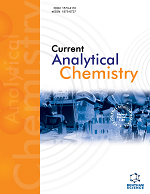- Home
- A-Z Publications
- Current Analytical Chemistry
- Previous Issues
- Volume 18, Issue 2, 2022
Current Analytical Chemistry - Volume 18, Issue 2, 2022
Volume 18, Issue 2, 2022
-
-
Fluorescent Carbon Dots and their Applications in Sensing of Small Organic Molecules
More LessAuthors: Sakib H. Laghari, Najma Memon, Muhammad Yar Khuhawer and Taj Muhammad JahangirBackground: Fluorescence-based sensing is considered highly sensitive and fluorescent probes with improved properties are always preferred. Fluorescent carbon dots (CDs) are newly emerging quasi-spherical nanoparticles of less than 10 nm in size and belong to the carbon nanomaterial’s family. CDs have great potential as fluorescent probes and currently are under open discussion by the researchers due to their striking p Read More
-
-
-
Importance of BODIPY-based Chemosensors for Cations and Anions in Bio-imaging Applications
More LessAuthors: Ahmed N. Kursunlu, Elif Bastug and Ersin GulerBackground: Chemosensor compounds are useful for sensitive, selective detection of cations and anions with fluorophore groups in an attempt to develop sufficient selectivity of the sensors. Although familiar fluorescent sensors utilize inter-molecular interactions with the cations and anions, an extraordinary endeavor was executed in the preparation of fluorescent-based sensor compounds. 4,4-difluoro-4- bora-3a,4a-diaza-s-ind Read More
-
-
-
Fluorescent Nanotechnology: An Evolution in Optical Sensors
More LessBackground: The optical properties of nanomaterials have evolved enormously with the introduction of nanotechnology. The property of materials to absorb and/or emit specific wavelength has turned them into one of the most favourite candidates to be effectively utilized in different sensing applications e.g, organic light emission diodes (OLEDs) sensors, gas sensors, biosensors, and fluorescent sensors. These materials have Read More
-
-
-
Role of Capping Agent for the Colorimetric and Fluorescent Sensing of Different Materials Using Metal Nanoparticles
More LessAuthors: Syed T. H. Sherazi, Sarfaraz A. Mahesar, Sirajuddin and Xiuzhu YuBackground: The selection of capping agent depends on the method of synthesis, nature of nanoparticles (NPs), and type of the compounds to be analyzed. Therefore, different types of capping agents such as surfactants, drugs, amino acids, fatty acids, and polymers are used to increase stability of NPs, avoid aggregation, keep NPs away from one another, thereby achieving desired morphology as well as the size of NPs. I Read More
-
-
-
A Novel Quinoline Derivative for Selective and Sensitive Visual Detection of PPB Level Cu2+ in an Aqueous Solution
More LessAuthors: Nilimesh Das, Tanmoy Khan, Aritra Das, Vipin K. Jain, Joydev Acharya, Md. S. H. Faizi, Joseph Daniel and Pratik SenAim: Selective and sensitive visual detection of Cu2+in aqueous solution at PPB level using an easily synthesized compound. Background: The search for a chemosensor that can detect Cu2+ is very long owing to the fact that an optimum level of Cu2+ is required for human health and the recommended amount of Cu2+ in drinking water is set to be 1-2 mgL-1. Thus, it is very important to detect Cu2+ even at a very low co Read More
-
-
-
A Fluorene based Fluorogenic "Turn-off" Chemosensor for the Recognition of Cu2+ and Fe2+: Computational Modeling and Living-cell Application
More LessBackground: The traditional methods for the detection and quantification of Cu2+ and Fe3+ heavy metal ions are usually troublesome in terms of high-cost, non-portable, time-consuming, specialized personnel and complicated tools, so their applications in practical analyses is limited. Therefore, the development of cheap, fast and simple-use techniques/instruments with high sensitivity/selectivity for the detection of he Read More
-
-
-
Recent Applications of Derivatization Techniques for Pharmaceutical and Bioanalytical Analysis through High-performance Liquid Chromatography
More LessAuthors: Raghav Dogra and Uttam K. MandalBackground: Derivatization of analytes is a quite convenient practice from an analytical perspective. Its vast prevalence is accounted by the availability of distinct reagents, primarily pragmatic for obtaining desired modifications in an analyte structure. Another reason for its handiness is typically to overcome limitations such as lack of sensitive methodology or instrumentation. The past decades have witnessed various ne Read More
-
-
-
A 96-Well Plates-based UV Spectrophotometric Assay for Determination of Total Glucosinolates in Isatis indigotica Roots
More LessAuthors: Yanzhi Sun, Hongchao Zhang and Zhihong ChengBackground: Glucosinolates (GLS) are important secondary metabolites in Cruciferae vegetables and herbs. Currently, the assays of total GLS determination are cumbersome (requiring acidic or enzymatic hydrolysis and addition of staining reagents), time-consuming, and indirect. High concentrations of inorganic salts are inevitably incorporated into the GLS products during separation. There is a need for a quantitative Read More
-
Volumes & issues
-
Volume 21 (2025)
-
Volume 20 (2024)
-
Volume 19 (2023)
-
Volume 18 (2022)
-
Volume 17 (2021)
-
Volume 16 (2020)
-
Volume 15 (2019)
-
Volume 14 (2018)
-
Volume 13 (2017)
-
Volume 12 (2016)
-
Volume 11 (2015)
-
Volume 10 (2014)
-
Volume 9 (2013)
-
Volume 8 (2012)
-
Volume 7 (2011)
-
Volume 6 (2010)
-
Volume 5 (2009)
-
Volume 4 (2008)
-
Volume 3 (2007)
-
Volume 2 (2006)
-
Volume 1 (2005)
Most Read This Month
Article
content/journals/cac
Journal
10
5
false
en


